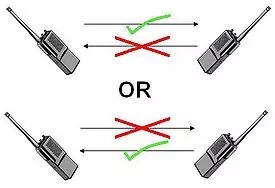What are the Data Transmission Modes
The data transmission modes include simplex, full-duplex and half-duplex.
Usually, the transmission mode that can only perform one-way data transmission in one direction is called simplex; the transmission mode that can perform two-way data transmission between two communication devices is called duplex. And duplex is divided into half duplex and full duplex.
Full-duplex system allows simultaneous bidirectional data transfer between two devices. The telephones and mobile phones we use every day are standard full-duplex systems. While speaking at one end, we can also hear the voice of the other party.
Although half-duplex system can allow two-way data transmission between two devices, the data in both directions cannot be carried out at the same time, and the data transmission at the other end must wait for the data transmission at one end to complete before starting the data transmission at the other end. Just like a walkie-talkie call, you need to wait for the other side to finish speaking before you can start speaking on this end.

According to different implementation methods of the duplex system, it can be subdivided into two types: time division duplex and frequency division duplex.
TDD is time division duplex, also known as time division multiplexing, which uses time division multiplexing technology to separate the transmitted and received signals. It is a process of using half-duplex transmission to simulate full-duplex transmission. In the time division duplex transmission system, it is necessary to set up a protection section in the adjacent section, but this will reduce the spectral efficiency, otherwise a synchronization mechanism needs to be added, so that the transmission of a device and the reception of another device can be Synchronize. The synchronization mechanism increases the complexity and cost of the system and reduces the flexibility of bandwidth usage. However, duplexing also has some obvious advantages in asymmetric data transmission. It can dynamically adjust the corresponding bandwidth according to the amount of data sent and received. When the amount of data sent is large, the sending bandwidth is increased, and vice versa. This allows for faster and more efficient sending and receiving of data.
Frequency division duplexing, also known as frequency division multiplexing, is a signal that uses frequency division multiplexing technology to separate data sent and received. This transmission method will waste a certain amount of bandwidth when switching between sending and receiving, so there will be a longer delay time, and its lines will be more complicated and power-hungry. However, this method is simpler and more efficient in radio transceiver planning, because the device will use different frequencies when sending and receiving, so that the device will not receive the data sent by itself, and the sending and receiving will not affect each other. . When the amount of data sent and received is similar, frequency division duplex has higher efficiency than time division duplex.

